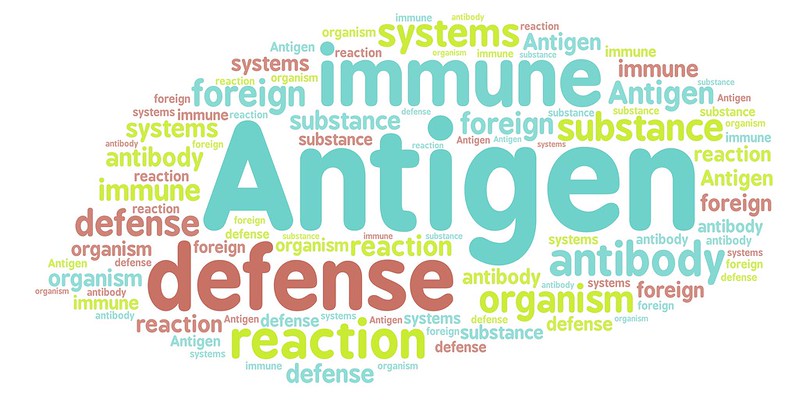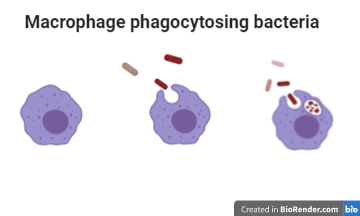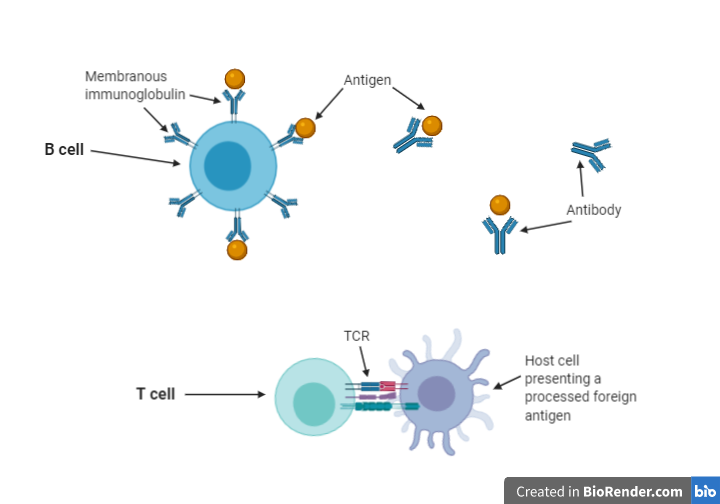One morning, you hang out with a friend who is coughing and sneezing. You spend some time together, you wish them well, and go home. A few days later, you wake up with a sore throat, a runny nose, and maybe a fever. What happened? You quickly remember your friend. You probably caught a virus. But what has your body already done to defend itself? And what else will it do in the next days to clear you from the virus so that you can return to your everyday life? That is the job of the immune system. A wide variety of organs, cells, and molecules, scattered around in your body, always ready to fight for your protection.

What is the immune system?
The immune system acts against every foreign substance or germ in the body. The most well-known pathogens it fights are viruses and bacteria. In order to do that, the immune system must be very good at identifying self from non-self. It consists of two distinct categories, innate and adaptive immunity, which are not mutually exclusive but collaborate in favor of the host.
Innate immunity
Innate immune response acts first. It is fast at recognizing something foreign and tries to prevent the microorganism from spreading to neighboring cells and tissues. However, it is not that effective and usually needs assistance from adaptive immunity, as we will discuss later. Furthermore, innate immunity is non-specific. That means the immune reaction is the same when it has to fight, for example, either the common cold virus or the bacterium causing tuberculosis.
Innate immunity involves a range of smart and carefully developed defense mechanisms. For example, the skin is considered part of the immune system, and more precisely, the first line of defense. That’s because it prevents microbes from penetrating the body unless there is a cut or mosquito bite, etc. Eyelashes are another physical barrier that prevents microbes from entering the eyes. Mucus in the respiratory tract creates an environment where microbes get trapped and carried away to protect the body from infection. The stomach produces stomach acid with low pH that is not the ideal environment for the survival of most pathogens. Of course, there is also an army of white blood cells that play a crucial role in the fight against invaders. These might be located in the tissues, such as macrophages, that identify the presence of an invader right away, or cells in the circulation that are recruited to the infection site by chemical signals. The latter can be neutrophils, monocytes, eosinophils, etc. The way the cells fight the microbe varies depending on the type of the cell. For instance, macrophages can engulf and kill a bacterium, in a process called phagocytosis. On the other hand, an eosinophil may release substances stored in granules that reinforce the immune response.

During these steps, inflammation occurs. Inflammation may sound like something dangerous, but it is normal and necessary for the host’s protection. Of course, there are some cases when inflammation can become threatening, but it is beyond the scope of this article. The four basic inflammatory signs are redness, swelling, pain, and heat. These result from the increased blood flow, fluids, and cells that die in the infected area. You may have felt that after injuring a finger. Below the skin, the immune system is fighting pathogens that entered your body through the injury. However, since the innate immunity is not always enough to destroy the microorganism, the adaptive immunity has to take action.
Adaptive immunity
It usually takes a few days for the adaptive immunity to be activated, meaning it is a slower process. However, upon activation, it is considered very effective due to its specificity against pathogens. Certain cell populations and molecules will be activated if the body is attacked by the common cold virus. Different cells and molecules will be required in the case of the tuberculosis bacterium, pointing out the innate-adaptive immunity difference. Another important feature of adaptive immunity is memory. That means the immune system remembers what pathogens it has encountered throughout the life of the organism. If a young child is infected with the measles virus, it will get sick and present the usual symptoms of this infectious disease. Adaptive immunity cells will recognize the unique characteristics of the measles virus that are absent from other viruses. This way, the child will acquire immunological memory against it. If the child reencounters the measles virus in the future, its immune system will stop the virus from replicating and causing the disease. Two types of cells comprise the adaptive immunity, B lymphocytes (or B cells) and T lymphocytes (or T cells).
B cells
B cells possess a molecule acting as a receptor on their surface, called membranous immunoglobulin, whose role is to recognize a specific antigen. Antigens are molecular structures of a pathogen that are targeted by B cells. That molecule differs among different B cells. When a B cell recognizes the presence of the antigen of its specialization, it becomes activated. Then, it can multiply and create a clone of B cells, all with the same specificity. B cells can have two different fates. They can either differentiate into plasma cells or memory B cells. What’s the difference between these two? Plasma cells produce a secreted form of the immunoglobulin we mentioned before, called an antibody. Antibodies are molecules that travel to various regions of the body, where they can find the antigen and eliminate it. Like many interactions in the molecular world, antibody and antigen match like a key in the lock. On the contrary, the role of memory B cells is to remain in the body. In case of future exposure to the same antigen, they get activated. They act fast and more accurately, preventing the pathogen from settling in the body.

T cells
Similarly, T cells possess a T-cell receptor (TCR) on their surface that can specifically recognize foreign molecules that have been processed by other normal cells of the body during the infection. Once again, different T cells recognize different processed molecules due to their unique receptors. There are two main types of T cells, T helper cells (TH cells), and cytotoxic T cells (TC cells). As the name suggests, T helper cells help other cells of the immune system, like B lymphocytes, fight the pathogen. On the contrary, when cytotoxic T cells are activated, they kill the host’s infected cells to prevent the pathogen from multiplying inside them. It is worth adding that TC cells can be a weapon against cancer. Since cancer cells differ from normal cells of the body, they are recognized as foreign by TC cells and are eliminated. As happens with B cells, when T cells are activated, they differentiate into effector T cells that act right away or to memory T cells ready to fight the same pathogen in the future.

For more information, go to:
